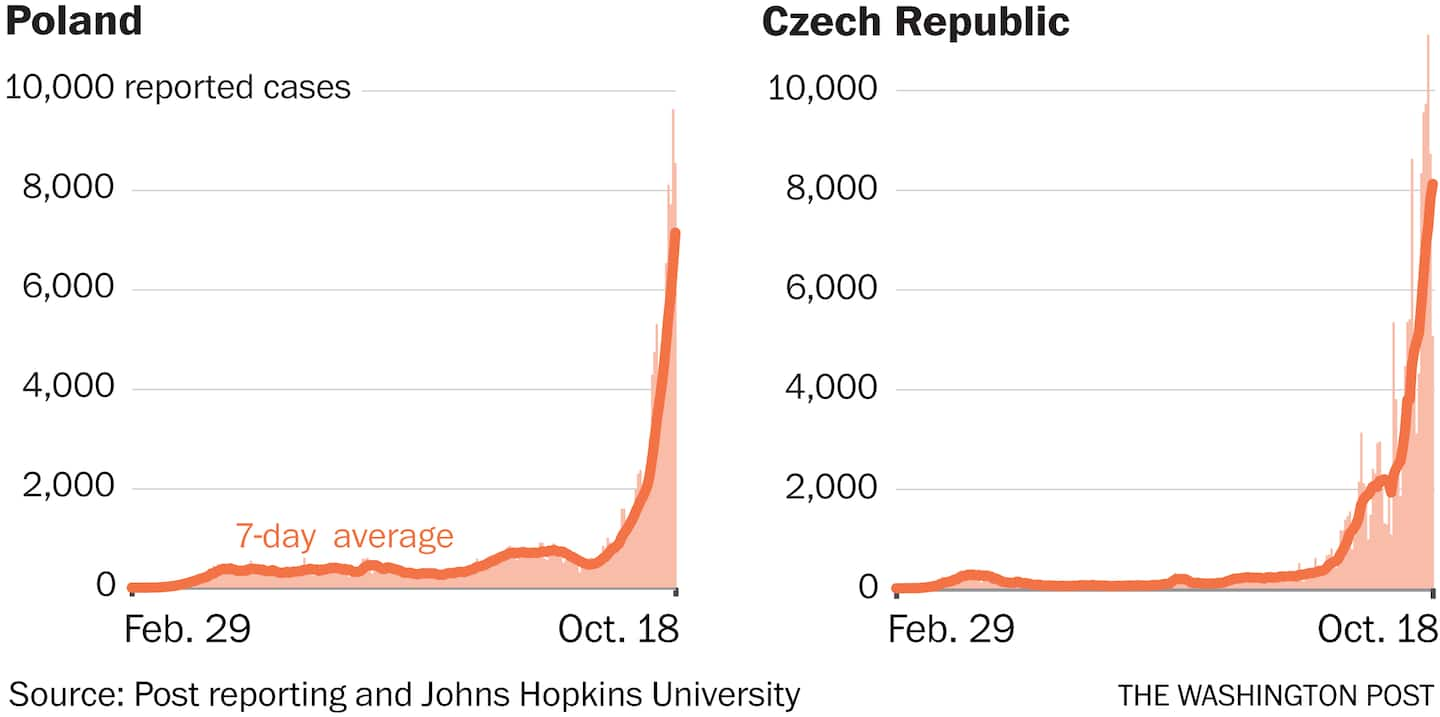Some countries that avoided initial coronavirus surge see first spike in cases

“Countries that have avoided the first waves have no reason to be complacent,” said Yanzhong Huang, a senior fellow for global health at the Council on Foreign Relations, adding that some countries avoided the first wave of the 1918 flu pandemic only to be hit harder later. “It might be a cursed blessing.”
The surge in new cases in some countries is stretching resources, prompting new measures. New daily cases reached a record 7,482 in Poland on Monday, as the government announced it would transform the National Stadium in Warsaw into a field hospital.
“We can see that the number of cases is growing so fast that we need to secure places for hospitalization for those who need it,” government spokesman Piotr Müller told state television.
In the Czech Republic, where 5,059 new cases were recorded on Sunday, the health minister resigned last month and was replaced by epidemiologist Roman Primula, who has called on Czech doctors who work abroad to return home to help the country’s overburdened health-care system.
There would be a “significant increase in the number of hospitalizations, severe coronavirus cases, and deaths” in the coming weeks, Primula warned in an address to the nation last week.
Only a few months ago, Poland and the Czech Republic were seen as success stories: In June, the German newspaper Die Welt wrote that Poland had “stood firm while others have stumbled.” At the time, the country of 38 million had confirmed fewer than 23,000 cases.
In early July, despite warnings from the World Health Organization, thousands attended a party in Prague to say “farewell” to the virus, which at that point had caused around 12,000 infections in the country of 10 million.
“We want to celebrate the end of the coronavirus crisis,” Ondrej Kobza, the party organizer and local cafe owner, told reporters.
Poland now has more than 183,000 confirmed cases, while the Czech Republic has around 174,000.
As of Monday, the Czech Republic had 492 new cases per 100,000 people in the past seven days, according to a Washington Post analysis, suggesting one of the fastest escalating outbreaks in the world. Poland had 140 new cases per 100,000, higher than other global hot spots such as the United States and Spain.
Other nearby countries in Central and Eastern Europe were also seeing a wave of new cases for the first time, including Slovenia, one of the first countries to declare itself virus-free in May. And there are nations that appeared to be seeing smaller or slower new waves, despite an earlier periods of relative respite.
In Latin America this summer, Argentina and Paraguay had been islands of stability as the virus raged in neighboring countries. But both have seen a steady, recent rise in cases since late summer, prompting new worries and restrictions.
This week, the South American Sports Organization confirmed that it would delay the 2022 South American Games in Asunción, Paraguay’s capital, by several months, as the “evolution of the COVID-19 pandemic has become unpredictable.”
Sri Lanka, a success story for South Asia earlier in the pandemic, saw a spike in new cases earlier this month that led to a stricter curfew and bans on large gatherings.
The virus has also spread widely for the first time over recent weeks in some countries in the Middle East. Jordan, in response to rising cases, imposed weekend curfews this month, and Lebanon shut bars and nightclubs.
Tunisia, which some experts suggested had “beaten” the coronavirus, is seeing daily case numbers hit record highs. The country, which had ordered a countrywide lockdown earlier in the pandemic, is now using local curfews to fight the virus.
In some cases, the resurgence of the virus appeared to come down to political factors. Judyth Twigg, a professor at Virginia Commonwealth University who specializes in global health, pointed to public fatigue in the face of government restrictions in the Czech Republic and other parts of Europe.
“These countries put strict lockdowns in place back in the spring precisely because they knew their health-care systems couldn’t handle a surge of moderate or severe cases,” Twigg said. “But as the months dragged on, populist leaders responded to public pressure to reopen economies and societies, and sure enough, the virus found its way in.”
Similar surges have not yet been recorded in some countries that undertook proactive measures, such Taiwan and Vietnam, while numerous African states, including giants such as Nigeria, appear to have kept the first wave under control. But the new surges in countries that had previously sidestepped major spikes show that early victories do not necessarily mean continued success in beating back the virus.
Huang noted that in the spring and summer of 1918, Austria-Hungary had been spared by the first viral wave of the flu pandemic then sweeping the world, but this may have left it more vulnerable in later, more deadly outbreaks, the devastation of which may have led to the dissolution of the empire.
Sema Sgaier, executive director of the Surgo Foundation and a Harvard professor, said that it did appear that some countries were less susceptible to the pandemic: Her foundation projects that much of sub-Saharan Africa is less likely to see large outbreaks, due in part to the young population in many nations.
But nothing is guaranteed. “Covid-19 is like an ocean wave: When it hits the right conditions, it breaks, causing turmoil,” Sgaier said. “The question is when the wave is going to reach your shore.”






